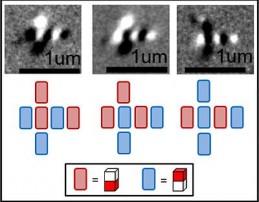Nanomagnet memory and logic could achieve ultimate energy efficiency
July 6, 2011

The bright spots are nanomagnets with their north ends pointing down (represented by red bar below) and the dark spots are north-up nanomagnets (blue). The six nanomagnets form a majority logic gate transistor, where the output on the right of the center bar is determined by the majority of three inputs on the top, left and bottom. (Credit: Bokor lab, UC Berkeley)
Future computers may rely on magnetic microprocessors that consume the least amount of energy allowed by the laws of physics, researchers at the University of California, Berkeley, have determined.
The researchers used nanomagnets to build magnetic memory and logic devices about 100 nanometers wide and about 200 nanometers long.
Because they have the same north-south polarity as a bar magnet, the up-or-down orientation of the pole can be used to represent the 0 and 1 of binary computer memory.
When multiple nanomagnets are brought together, their north and south poles interact via dipole-dipole forces to exhibit transistor behavior, allowing simple logic operations.
Such devices would dissipate only 18 millielectron volts of energy per operation at room temperature, the minimum allowed by the second law of thermodynamics, the Landauer limit. That’s 1 million times less energy per operation than consumed by today’s computers, the researchers said.
Ref.: Brian Lambson, David Carlton, Jeffrey Bokor, Exploring the Thermodynamic Limits of Computation in Integrated Systems: Magnetic Memory, Nanomagnetic Logic, and the Landauer Limit, Physical Review Letters, 2011; 107: 010604 [DOI: 10.1103/PhysRevLett.107.010604]